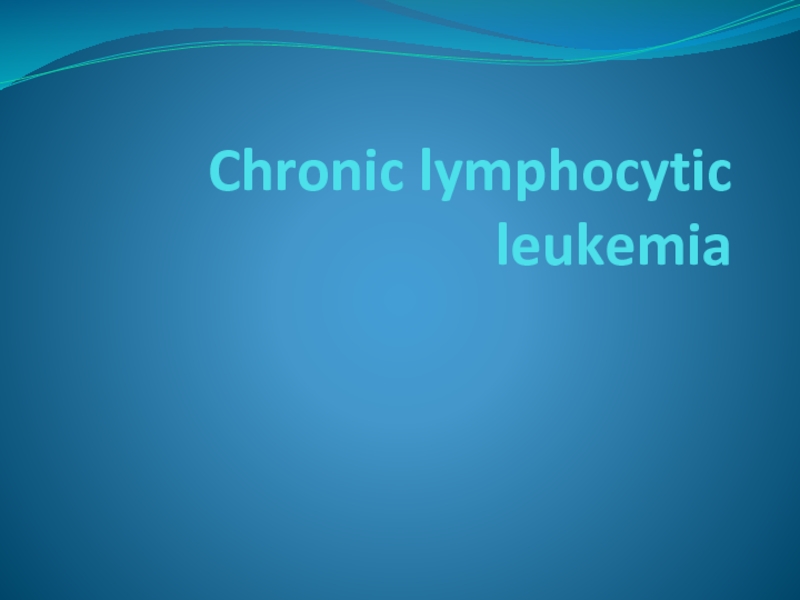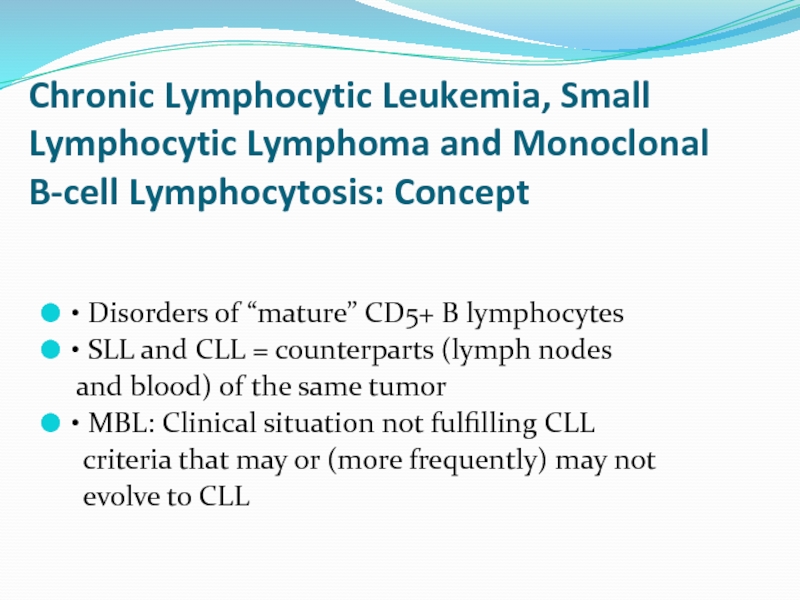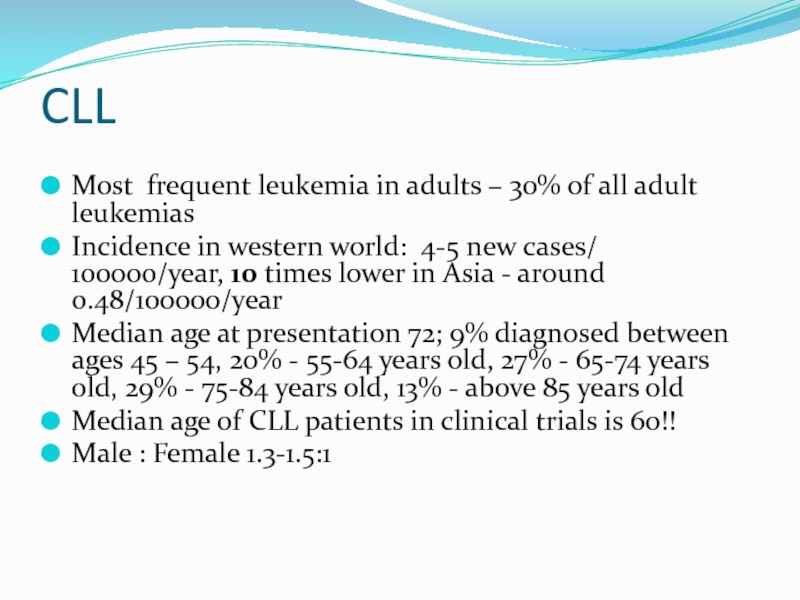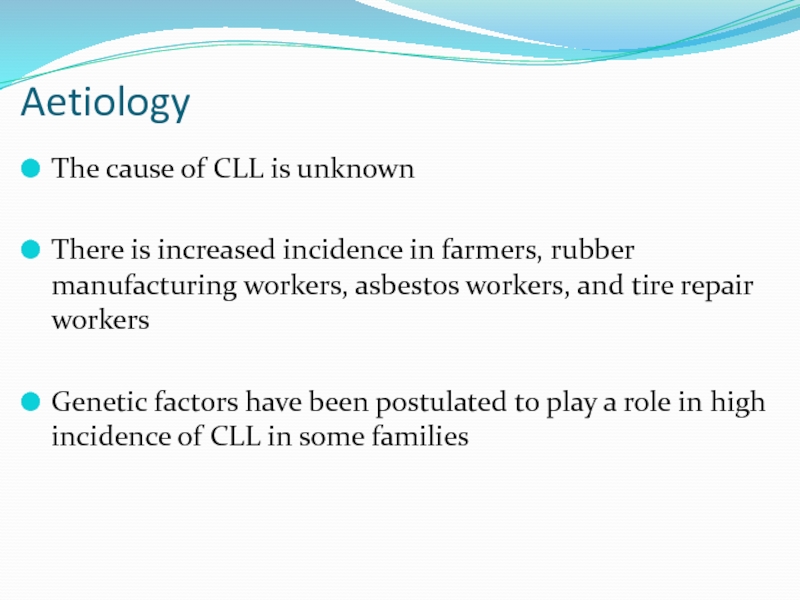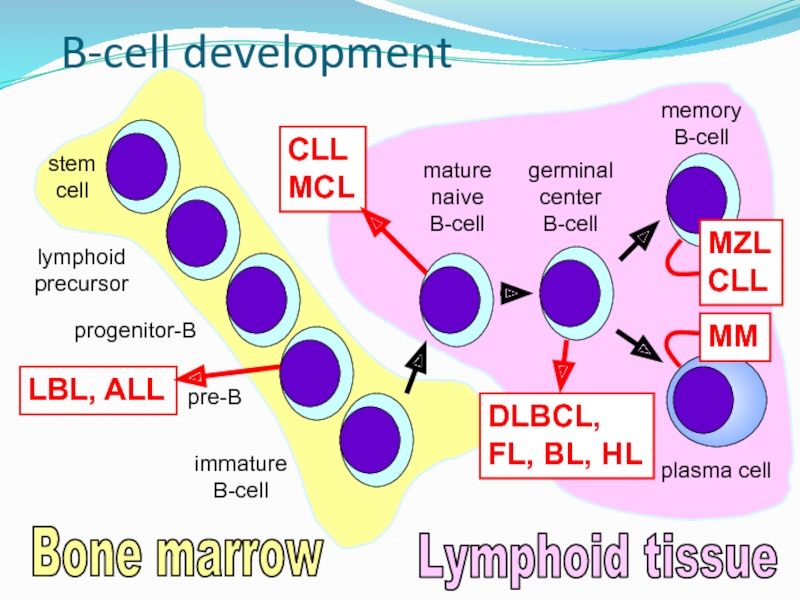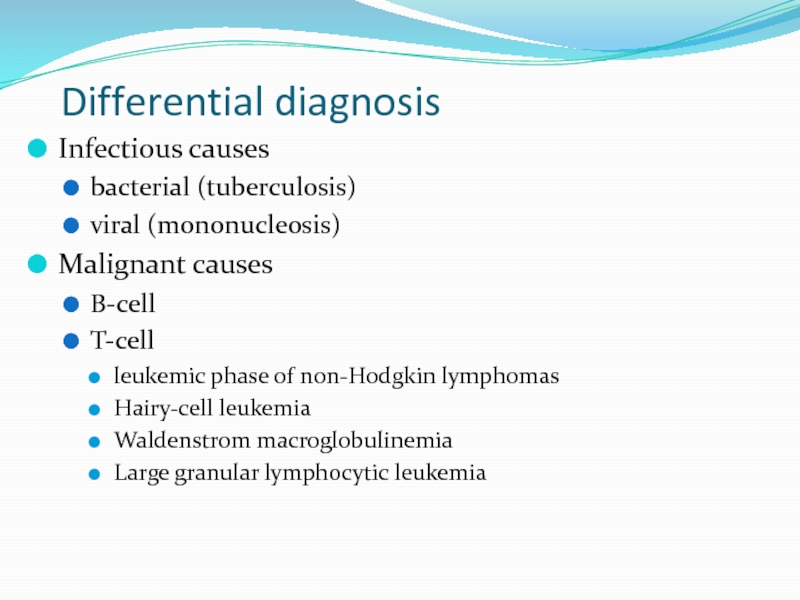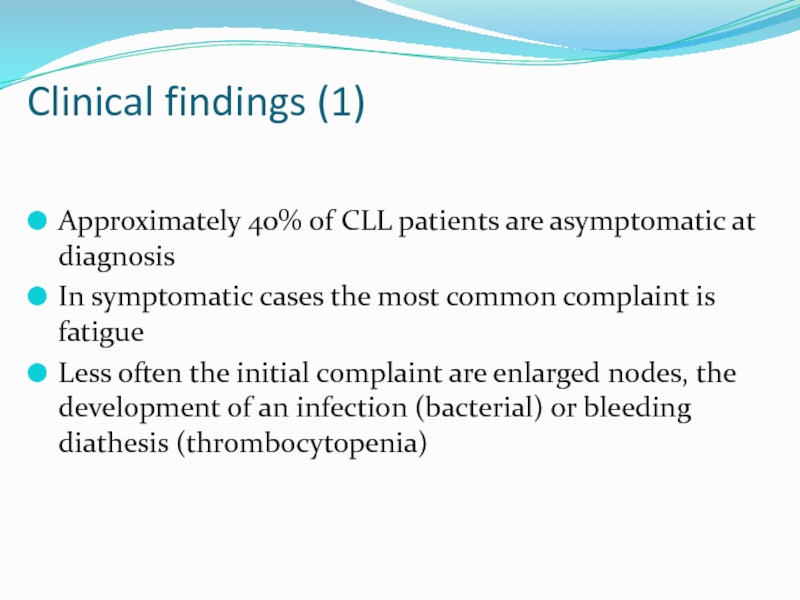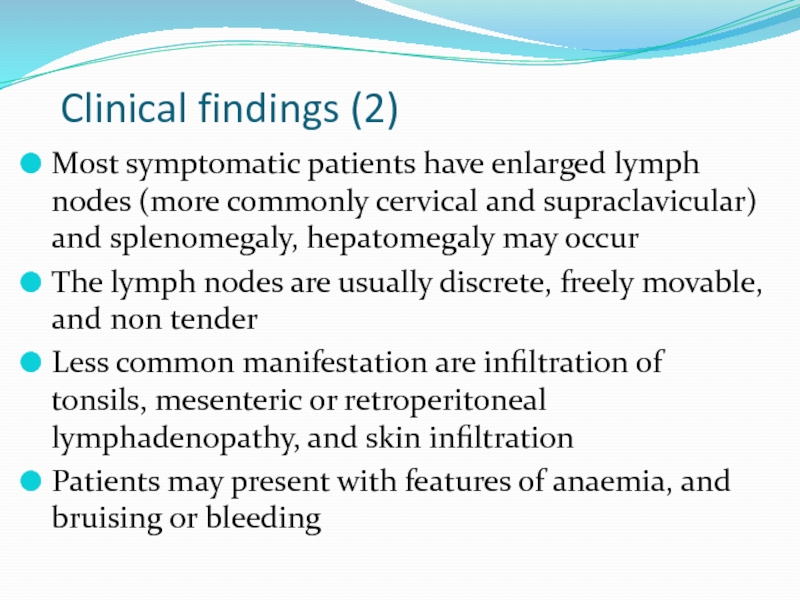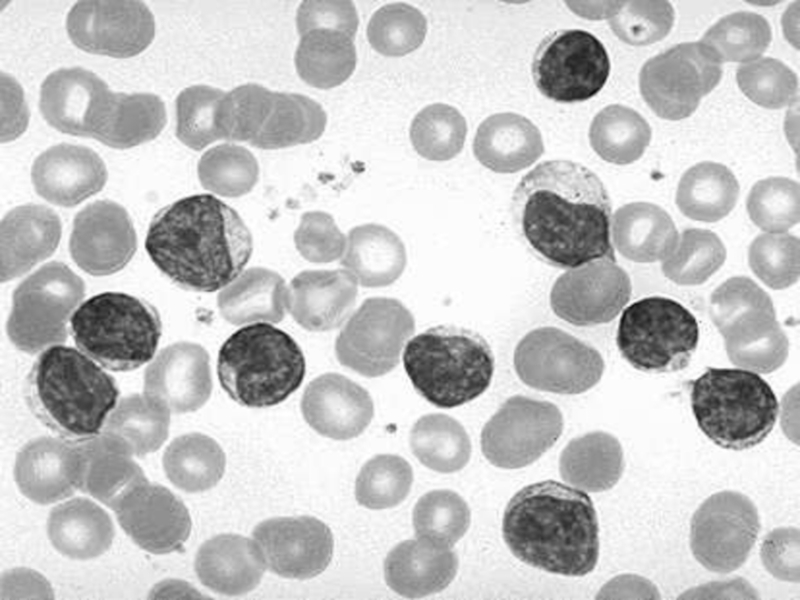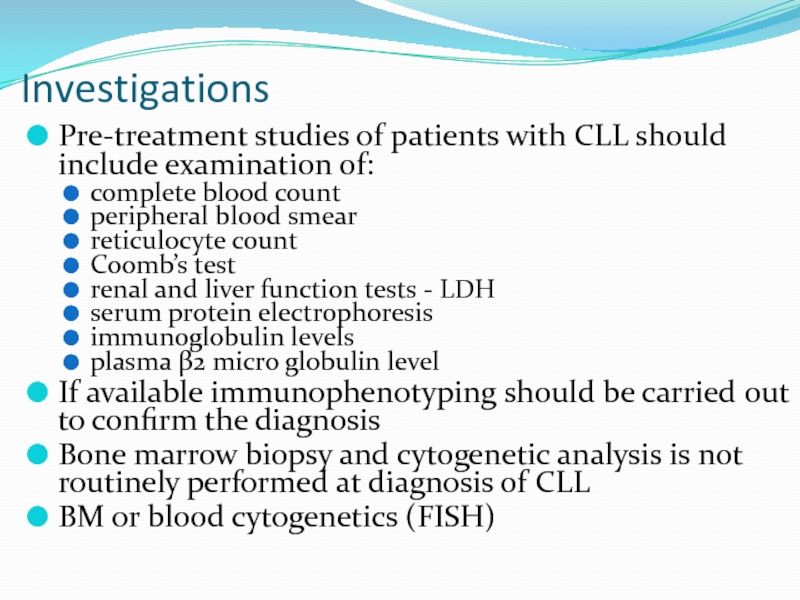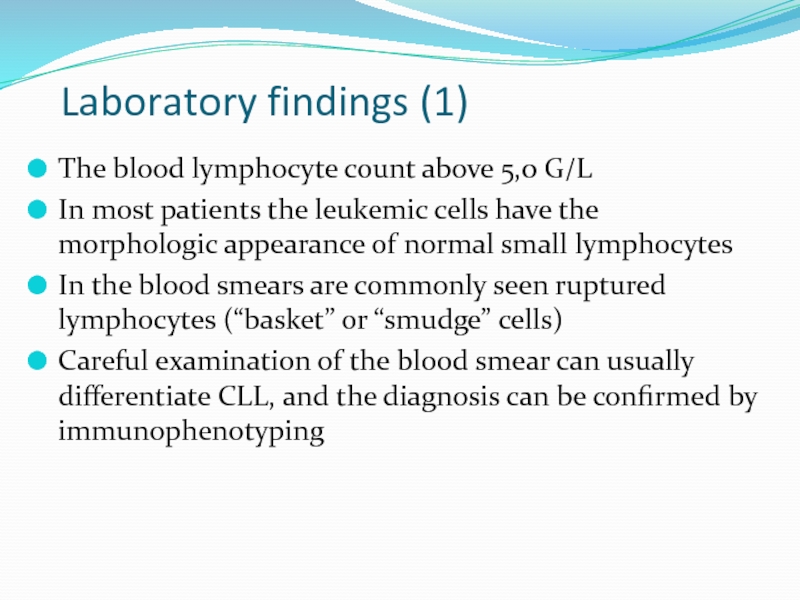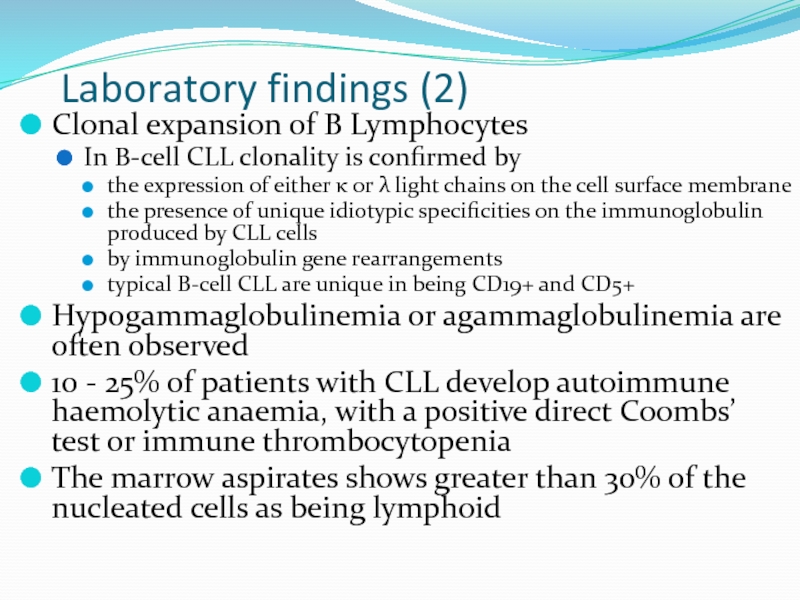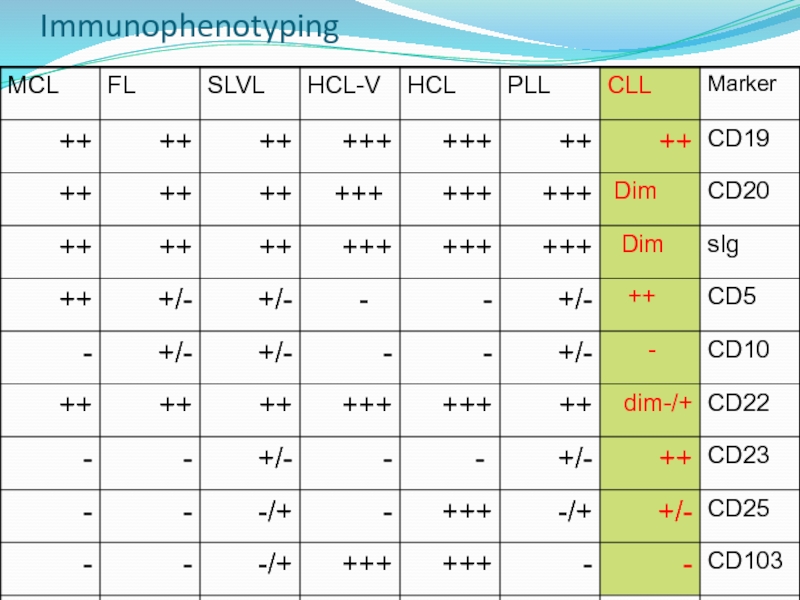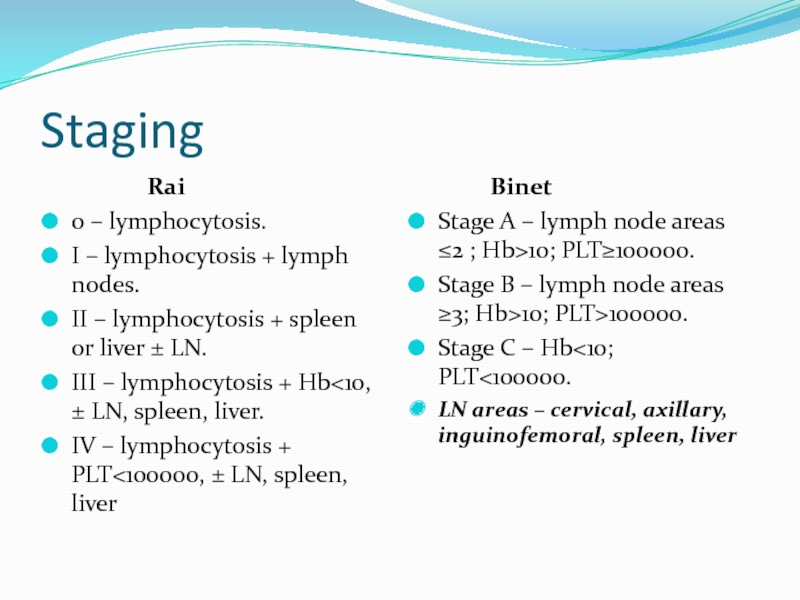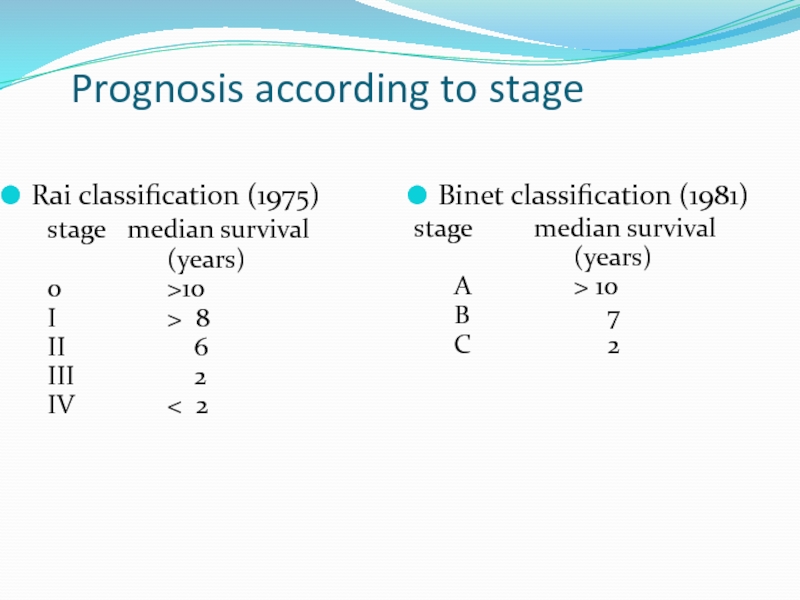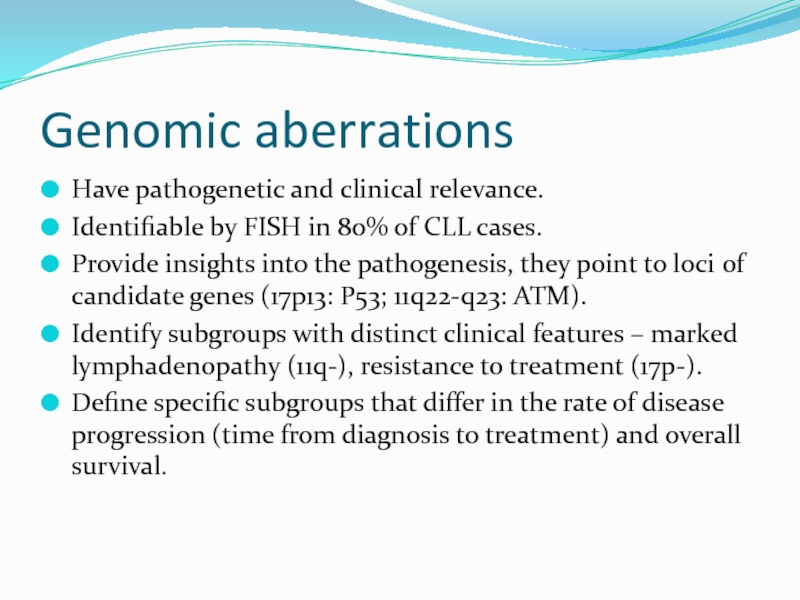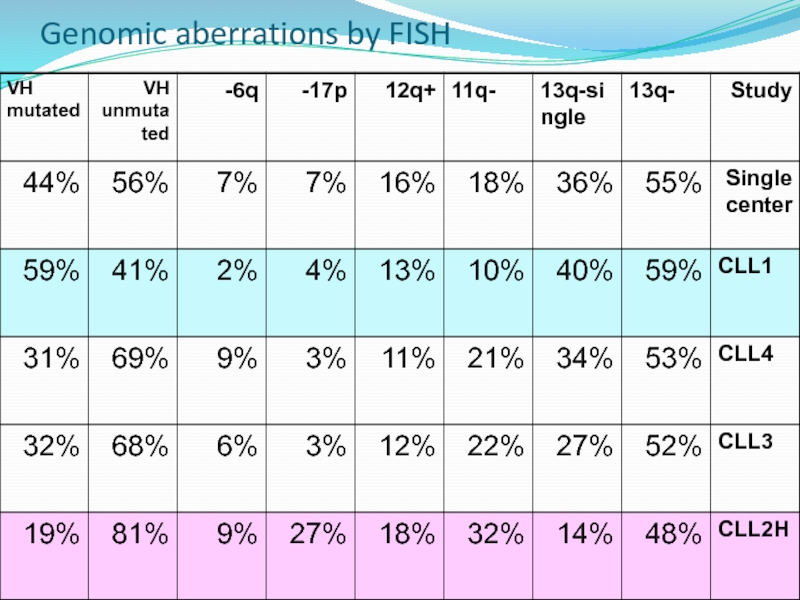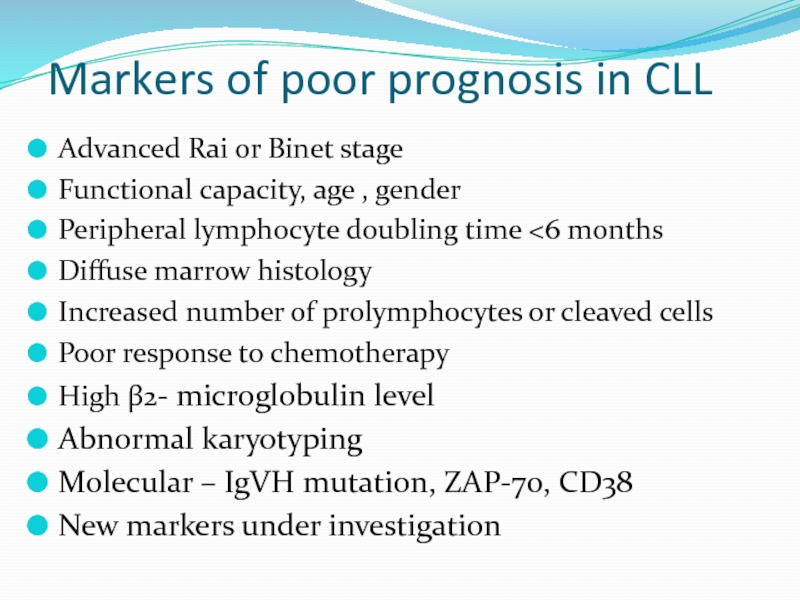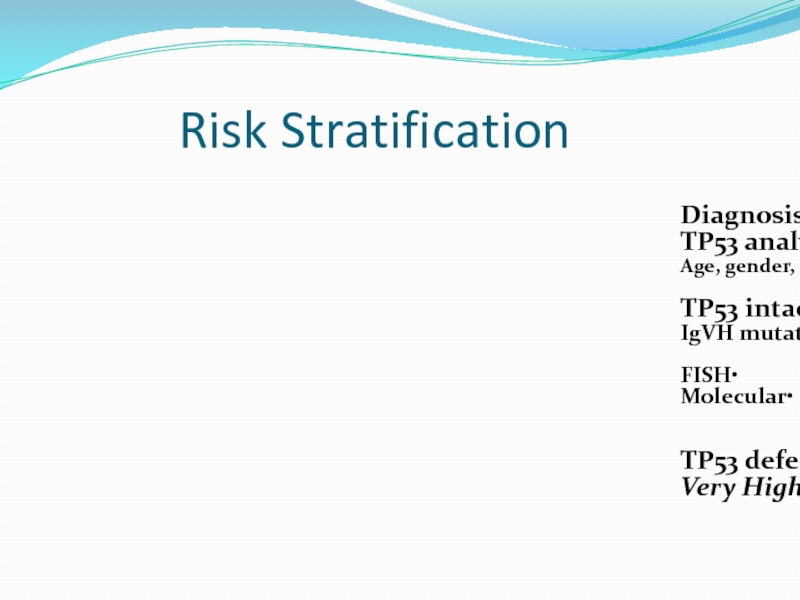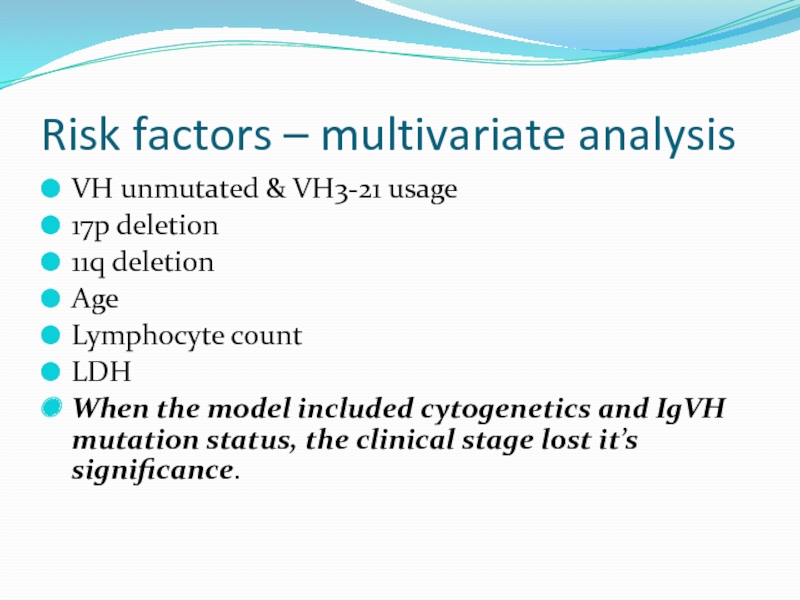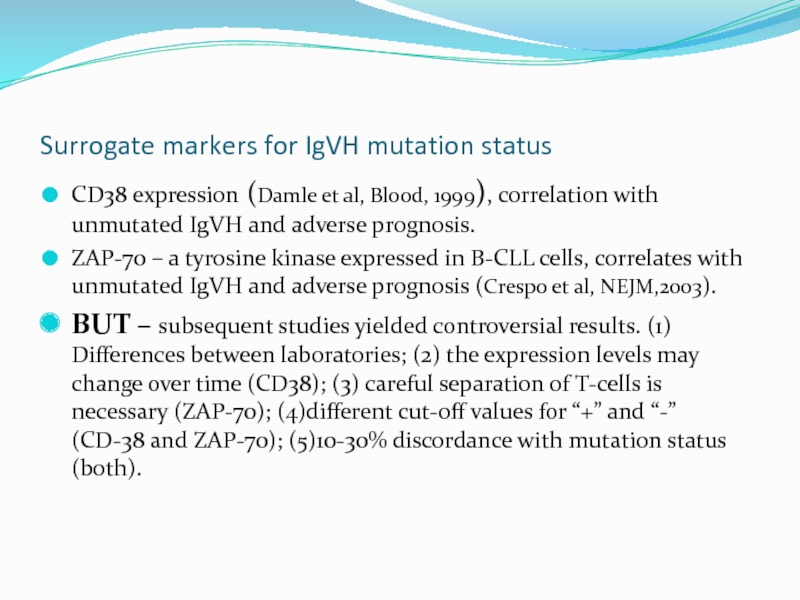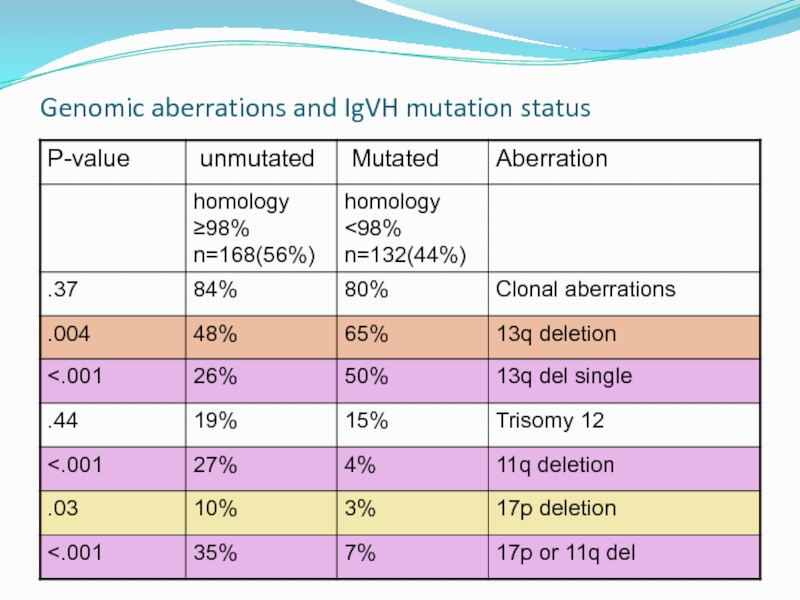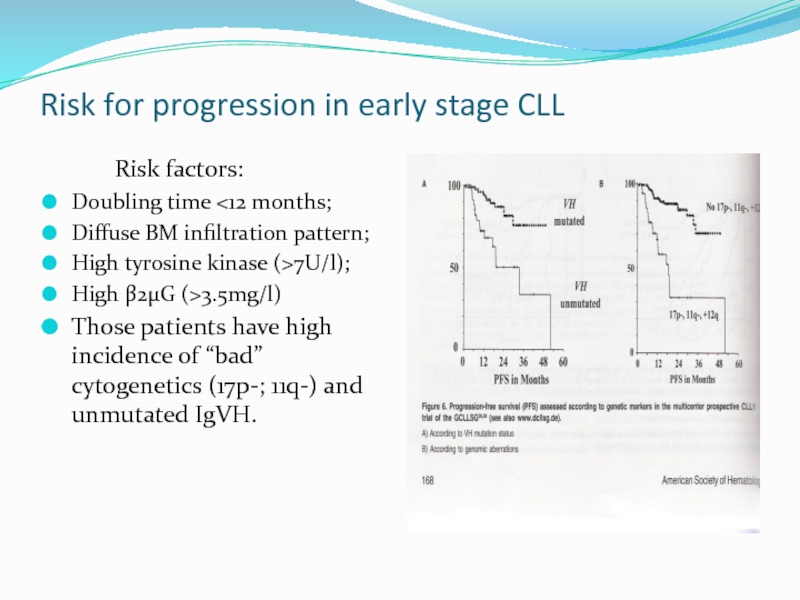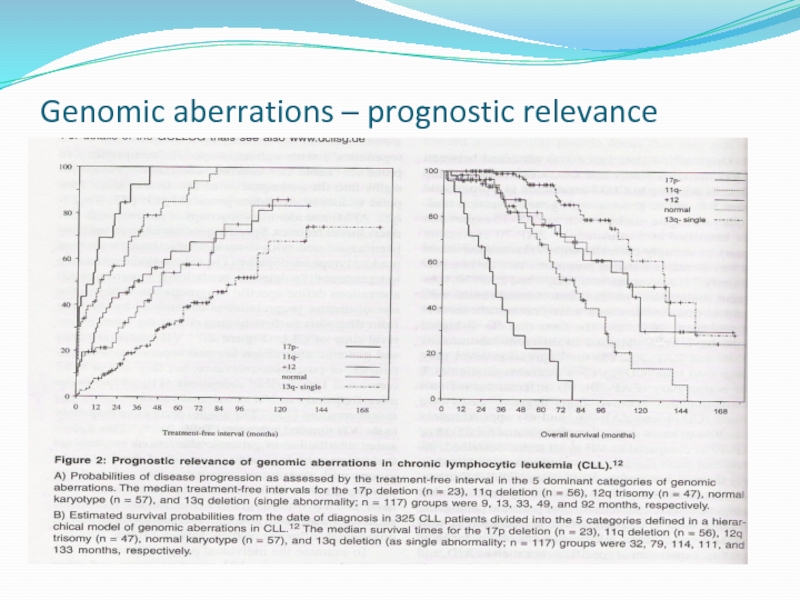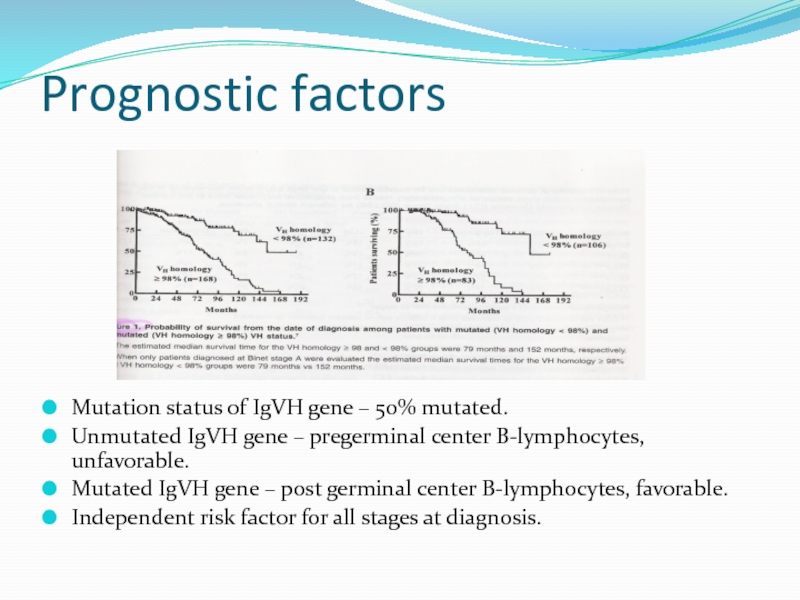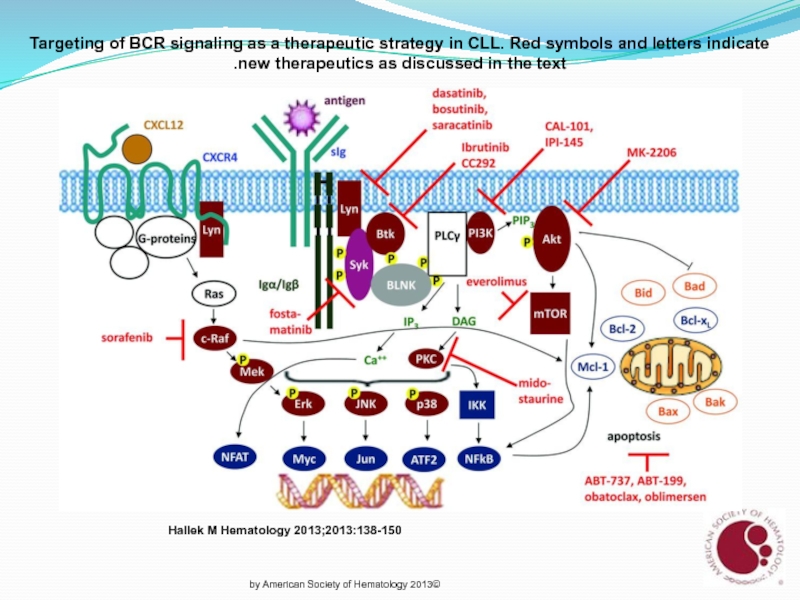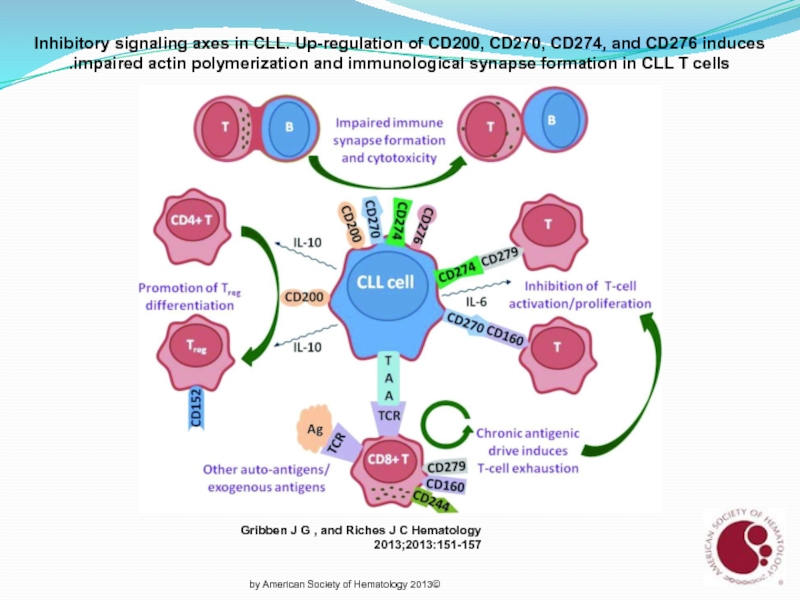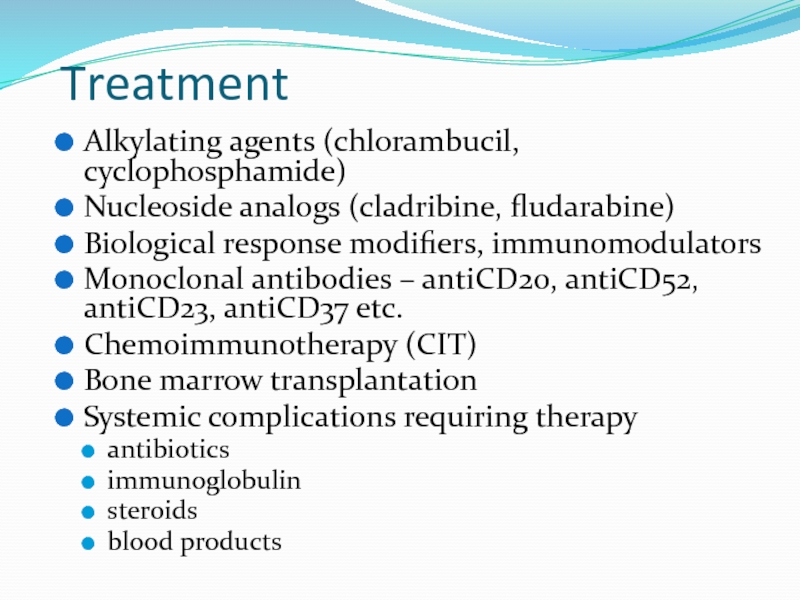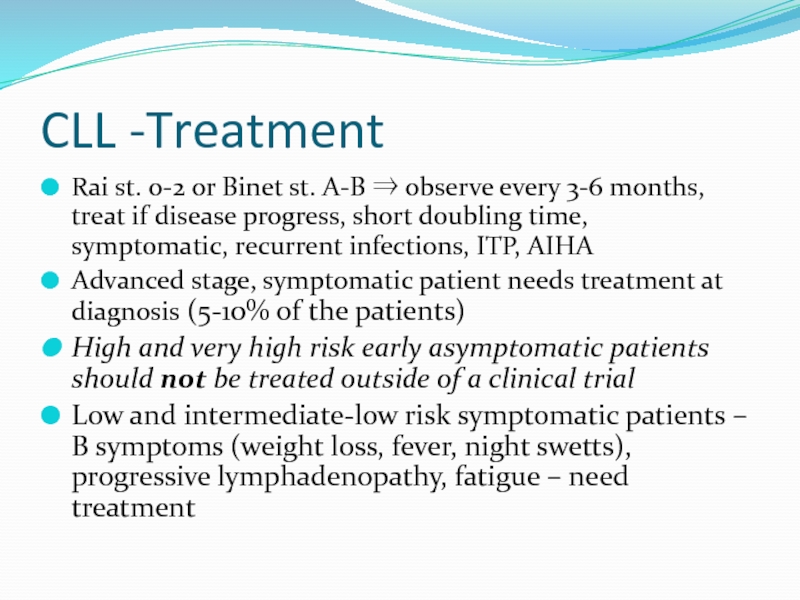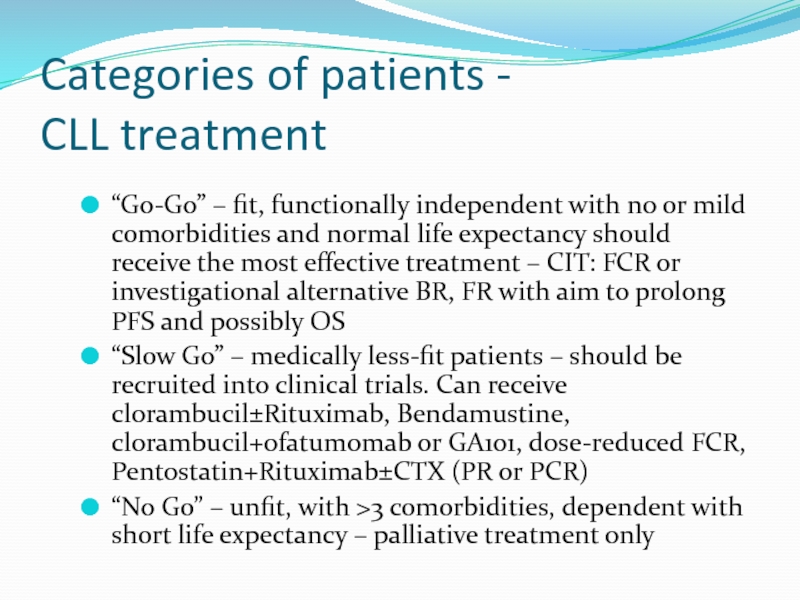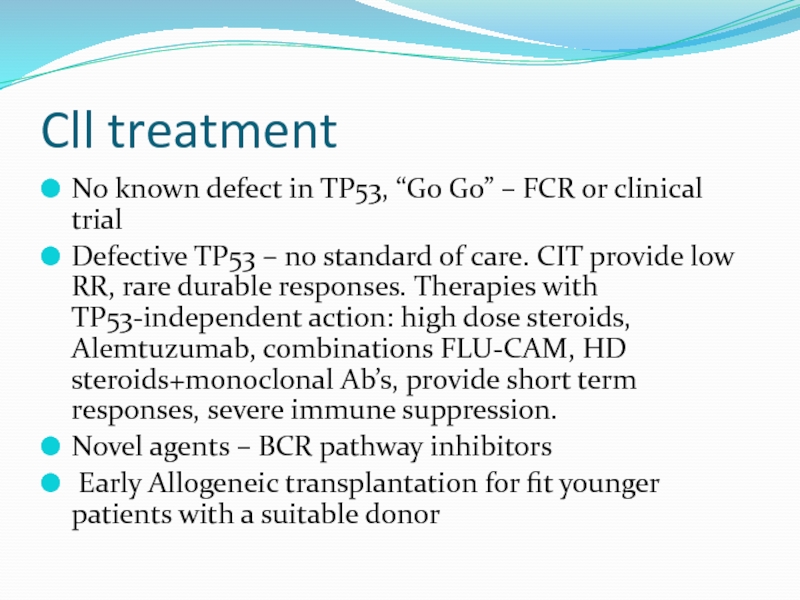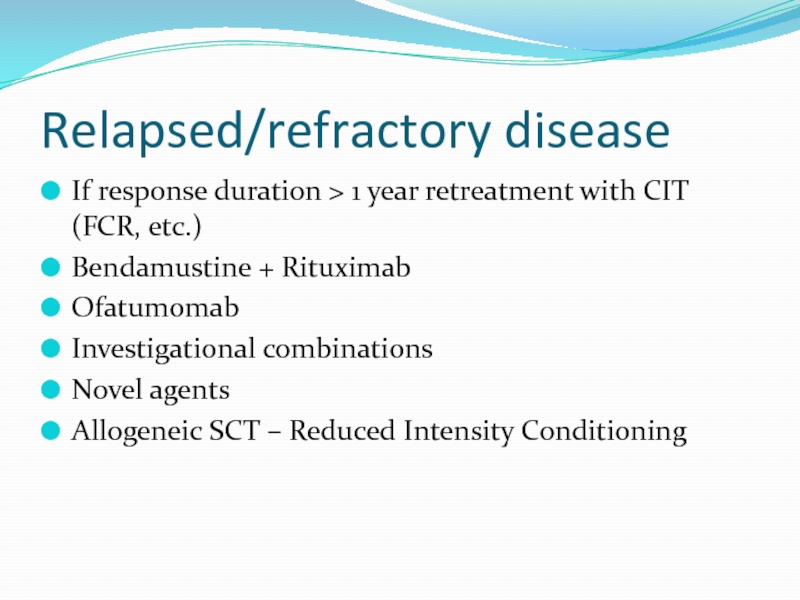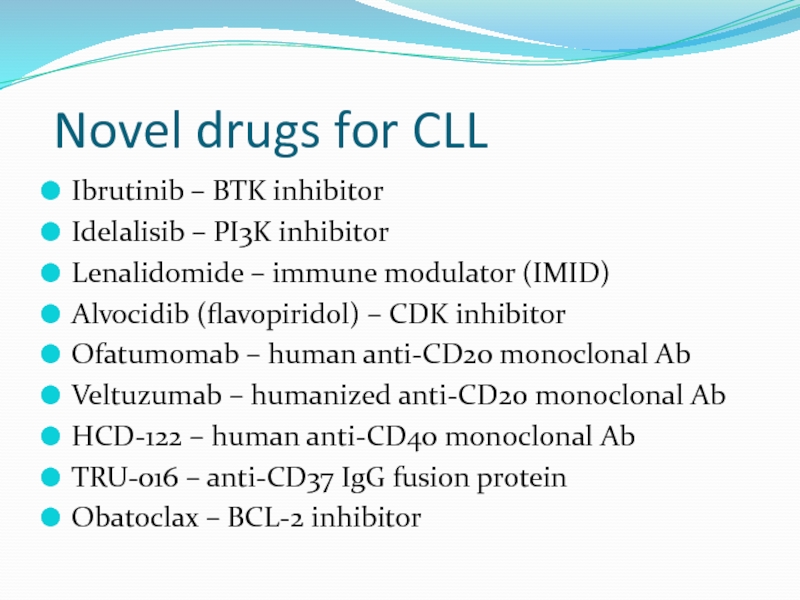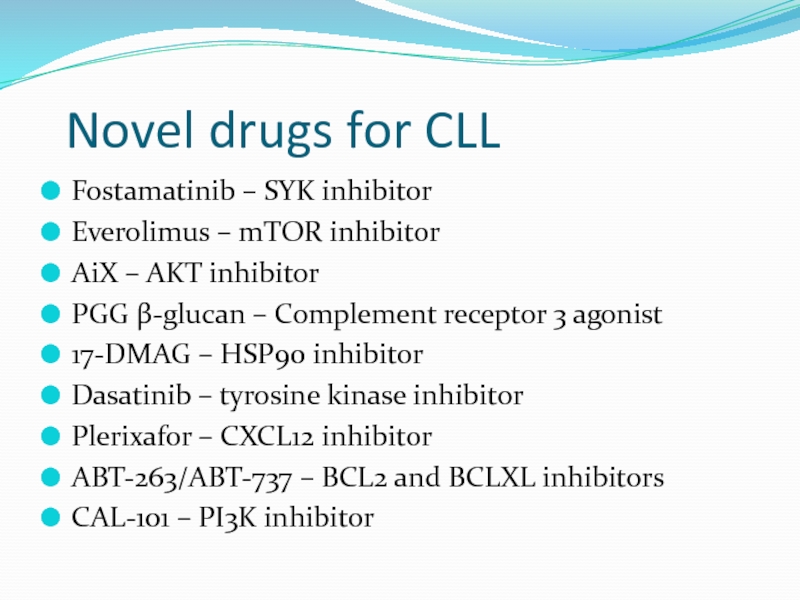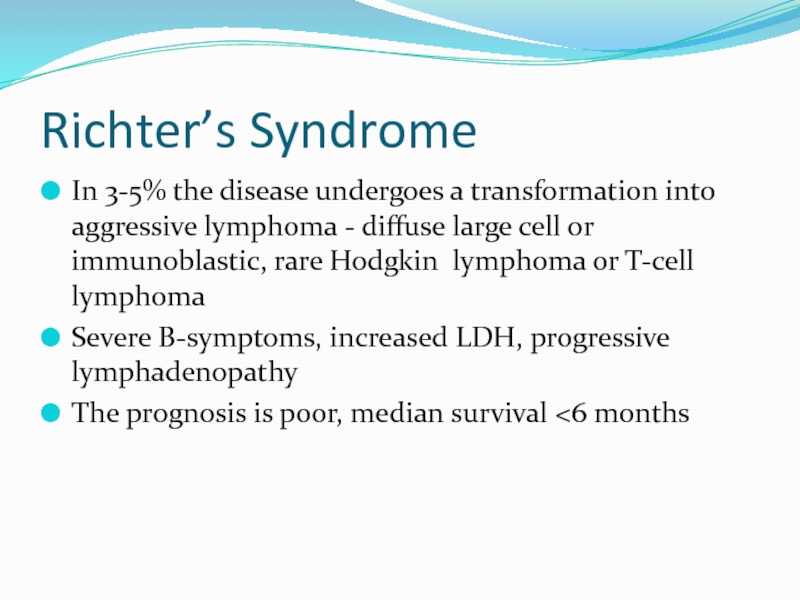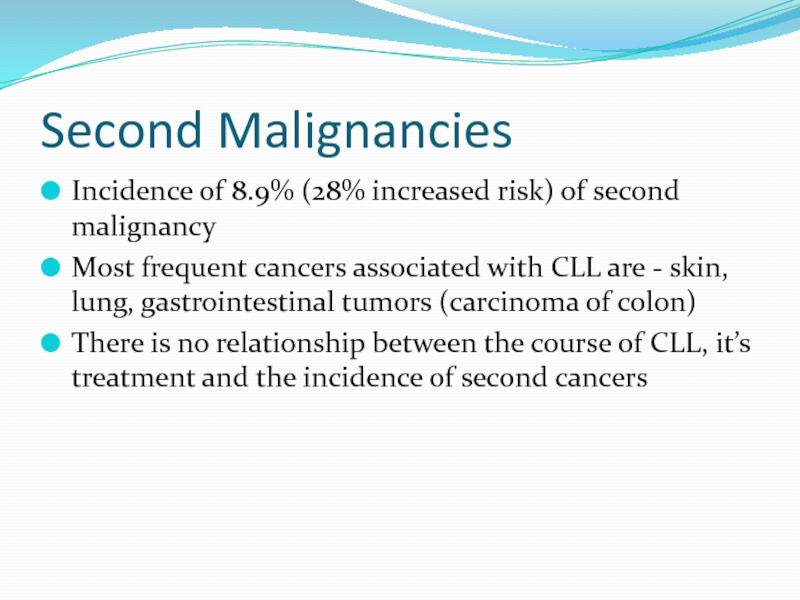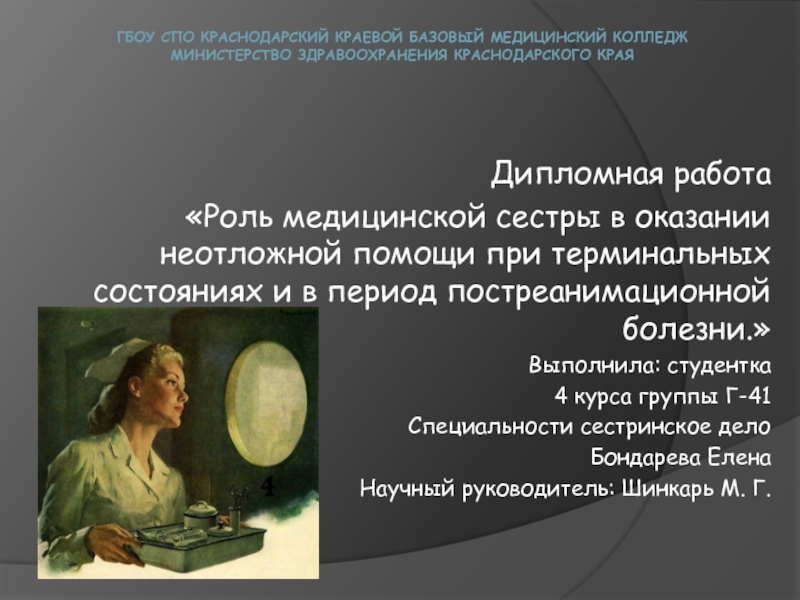- Главная
- Разное
- Дизайн
- Бизнес и предпринимательство
- Аналитика
- Образование
- Развлечения
- Красота и здоровье
- Финансы
- Государство
- Путешествия
- Спорт
- Недвижимость
- Армия
- Графика
- Культурология
- Еда и кулинария
- Лингвистика
- Английский язык
- Астрономия
- Алгебра
- Биология
- География
- Детские презентации
- Информатика
- История
- Литература
- Маркетинг
- Математика
- Медицина
- Менеджмент
- Музыка
- МХК
- Немецкий язык
- ОБЖ
- Обществознание
- Окружающий мир
- Педагогика
- Русский язык
- Технология
- Физика
- Философия
- Химия
- Шаблоны, картинки для презентаций
- Экология
- Экономика
- Юриспруденция
Chronic Lymphocytic Leukemia презентация
Содержание
- 1. Chronic Lymphocytic Leukemia
- 2. Chronic Lymphocytic Leukemia, Small Lymphocytic
- 3. Monoclonal B lymphocytosis SmIg
- 4. CLL Most frequent leukemia in adults –
- 5. Aetiology The cause of CLL is
- 6. B-cell development
- 7. Differential diagnosis Infectious causes bacterial (tuberculosis) viral
- 8. Clinical findings (1) Approximately 40% of CLL
- 9. Clinical findings (2) Most symptomatic patients have
- 11. Investigations Pre-treatment studies of patients with CLL
- 12. Laboratory findings (1) The blood lymphocyte count
- 13. Laboratory findings (2) Clonal expansion of B
- 14. Immunophenotyping
- 15. Staging
- 16. Prognosis according to stage Rai classification
- 17. Genomic aberrations Have pathogenetic and clinical relevance.
- 18. Genomic aberrations by FISH
- 19. Markers of poor prognosis in CLL Advanced
- 20. Risk
- 21. Risk factors – multivariate analysis VH unmutated
- 22. Surrogate markers for IgVH mutation status CD38
- 23. Genomic aberrations and IgVH mutation status
- 24. Risk for progression in early stage CLL
- 25. Genomic aberrations – prognostic relevance
- 26. Prognostic factors Mutation status of IgVH
- 27. Targeting of BCR signaling as a therapeutic
- 28. Inhibitory signaling axes in CLL. Up-regulation of
- 29. Treatment Alkylating agents (chlorambucil, cyclophosphamide) Nucleoside analogs
- 30. CLL -Treatment Rai st. 0-2 or Binet
- 31. Categories of patients -
- 32. Cll treatment No known defect in TP53,
- 33. Relapsed/refractory disease If response duration >
- 34. Novel drugs for CLL Ibrutinib –
- 35. Novel drugs for CLL Fostamatinib –
- 36. Richter’s Syndrome In 3-5% the disease undergoes
- 37. Second Malignancies Incidence of 8.9% (28% increased
- 38. תודה רבה
Слайд 2
Chronic Lymphocytic Leukemia, Small Lymphocytic Lymphoma and Monoclonal B-cell Lymphocytosis: Concept
•
• SLL and CLL = counterparts (lymph nodes
and blood) of the same tumor
• MBL: Clinical situation not fulfilling CLL
criteria that may or (more frequently) may not
evolve to CLL
Слайд 3
Monoclonal B lymphocytosis
SmIg weak, CD5+, CD19+, CD23+,
CD20 weak
NO→MBL
YES→SLL
>5000/microL
CLL
Слайд 4CLL
Most frequent leukemia in adults – 30% of all adult leukemias
Incidence
Median age at presentation 72; 9% diagnosed between ages 45 – 54, 20% - 55-64 years old, 27% - 65-74 years old, 29% - 75-84 years old, 13% - above 85 years old
Median age of CLL patients in clinical trials is 60!!
Male : Female 1.3-1.5:1
Слайд 5Aetiology
The cause of CLL is unknown
There is increased incidence in
Genetic factors have been postulated to play a role in high incidence of CLL in some families
Слайд 7Differential diagnosis
Infectious causes
bacterial (tuberculosis)
viral (mononucleosis)
Malignant causes
B-cell
T-cell
leukemic phase of non-Hodgkin lymphomas
Hairy-cell leukemia
Waldenstrom
Large granular lymphocytic leukemia
Слайд 8Clinical findings (1)
Approximately 40% of CLL patients are asymptomatic at diagnosis
In
Less often the initial complaint are enlarged nodes, the development of an infection (bacterial) or bleeding diathesis (thrombocytopenia)
Слайд 9Clinical findings (2)
Most symptomatic patients have enlarged lymph nodes (more commonly
The lymph nodes are usually discrete, freely movable, and non tender
Less common manifestation are infiltration of tonsils, mesenteric or retroperitoneal lymphadenopathy, and skin infiltration
Patients may present with features of anaemia, and bruising or bleeding
Слайд 11Investigations
Pre-treatment studies of patients with CLL should include examination of:
complete blood
peripheral blood smear
reticulocyte count
Coomb’s test
renal and liver function tests - LDH
serum protein electrophoresis
immunoglobulin levels
plasma β2 micro globulin level
If available immunophenotyping should be carried out to confirm the diagnosis
Bone marrow biopsy and cytogenetic analysis is not routinely performed at diagnosis of CLL
BM or blood cytogenetics (FISH)
Слайд 12Laboratory findings (1)
The blood lymphocyte count above 5,0 G/L
In most patients
In the blood smears are commonly seen ruptured lymphocytes (“basket” or “smudge” cells)
Careful examination of the blood smear can usually differentiate CLL, and the diagnosis can be confirmed by immunophenotyping
Слайд 13Laboratory findings (2)
Clonal expansion of B Lymphocytes
In B-cell CLL clonality is
the expression of either κ or λ light chains on the cell surface membrane
the presence of unique idiotypic specificities on the immunoglobulin produced by CLL cells
by immunoglobulin gene rearrangements
typical B-cell CLL are unique in being CD19+ and CD5+
Hypogammaglobulinemia or agammaglobulinemia are often observed
10 - 25% of patients with CLL develop autoimmune haemolytic anaemia, with a positive direct Coombs’ test or immune thrombocytopenia
The marrow aspirates shows greater than 30% of the nucleated cells as being lymphoid
Слайд 15Staging
Rai
0
I – lymphocytosis + lymph nodes.
II – lymphocytosis + spleen or liver ± LN.
III – lymphocytosis + Hb<10, ± LN, spleen, liver.
IV – lymphocytosis + PLT<100000, ± LN, spleen, liver
Binet
Stage A – lymph node areas ≤2 ; Hb>10; PLT≥100000.
Stage B – lymph node areas ≥3; Hb>10; PLT>100000.
Stage C – Hb<10; PLT<100000.
LN areas – cervical, axillary, inguinofemoral, spleen, liver
Слайд 16 Prognosis according to stage
Rai classification (1975)
stage median survival
(years)
0 >10
I > 8
II 6
III
IV < 2
Binet classification (1981)
stage median survival
(years)
A > 10
B 7
C 2
Слайд 17Genomic aberrations
Have pathogenetic and clinical relevance.
Identifiable by FISH in 80% of
Provide insights into the pathogenesis, they point to loci of candidate genes (17p13: P53; 11q22-q23: ATM).
Identify subgroups with distinct clinical features – marked lymphadenopathy (11q-), resistance to treatment (17p-).
Define specific subgroups that differ in the rate of disease progression (time from diagnosis to treatment) and overall survival.
Слайд 19Markers of poor prognosis in CLL
Advanced Rai or Binet stage
Functional capacity,
Peripheral lymphocyte doubling time <6 months
Diffuse marrow histology
Increased number of prolymphocytes or cleaved cells
Poor response to chemotherapy
High β2- microglobulin level
Abnormal karyotyping
Molecular – IgVH mutation, ZAP-70, CD38
New markers under investigation
Слайд 20 Risk Stratification
Diagnosis
TP53 analysis
Age, gender,
TP53 intact
IgVH mutation
FISH
Molecular
TP53 defective
Very High Risk
Слайд 21Risk factors – multivariate analysis
VH unmutated & VH3-21 usage
17p deletion
11q
Age
Lymphocyte count
LDH
When the model included cytogenetics and IgVH mutation status, the clinical stage lost it’s significance.
Слайд 22Surrogate markers for IgVH mutation status
CD38 expression (Damle et al, Blood,
ZAP-70 – a tyrosine kinase expressed in B-CLL cells, correlates with unmutated IgVH and adverse prognosis (Crespo et al, NEJM,2003).
BUT – subsequent studies yielded controversial results. (1) Differences between laboratories; (2) the expression levels may change over time (CD38); (3) careful separation of T-cells is necessary (ZAP-70); (4)different cut-off values for “+” and “-” (CD-38 and ZAP-70); (5)10-30% discordance with mutation status (both).
Слайд 24Risk for progression in early stage CLL
Doubling time <12 months;
Diffuse BM infiltration pattern;
High tyrosine kinase (>7U/l);
High β2µG (>3.5mg/l)
Those patients have high incidence of “bad” cytogenetics (17p-; 11q-) and unmutated IgVH.
Слайд 26Prognostic factors
Mutation status of IgVH gene – 50% mutated.
Unmutated IgVH
Mutated IgVH gene – post germinal center B-lymphocytes, favorable.
Independent risk factor for all stages at diagnosis.
Слайд 27Targeting of BCR signaling as a therapeutic strategy in CLL. Red
Hallek M Hematology 2013;2013:138-150
©2013 by American Society of Hematology
Слайд 28Inhibitory signaling axes in CLL. Up-regulation of CD200, CD270, CD274, and
Gribben J G , and Riches J C Hematology 2013;2013:151-157
©2013 by American Society of Hematology
Слайд 29Treatment
Alkylating agents (chlorambucil, cyclophosphamide)
Nucleoside analogs (cladribine, fludarabine)
Biological response modifiers, immunomodulators
Monoclonal antibodies
Chemoimmunotherapy (CIT)
Bone marrow transplantation
Systemic complications requiring therapy
antibiotics
immunoglobulin
steroids
blood products
Слайд 30CLL -Treatment
Rai st. 0-2 or Binet st. A-B ⇒ observe every
Advanced stage, symptomatic patient needs treatment at diagnosis (5-10% of the patients)
High and very high risk early asymptomatic patients should not be treated outside of a clinical trial
Low and intermediate-low risk symptomatic patients – B symptoms (weight loss, fever, night swetts), progressive lymphadenopathy, fatigue – need treatment
Слайд 31Categories of patients -
“Go-Go” – fit, functionally independent with no or mild comorbidities and normal life expectancy should receive the most effective treatment – CIT: FCR or investigational alternative BR, FR with aim to prolong PFS and possibly OS
“Slow Go” – medically less-fit patients – should be recruited into clinical trials. Can receive clorambucil±Rituximab, Bendamustine, clorambucil+ofatumomab or GA101, dose-reduced FCR, Pentostatin+Rituximab±CTX (PR or PCR)
“No Go” – unfit, with >3 comorbidities, dependent with short life expectancy – palliative treatment only
Слайд 32Cll treatment
No known defect in TP53, “Go Go” – FCR or
Defective TP53 – no standard of care. CIT provide low RR, rare durable responses. Therapies with TP53-independent action: high dose steroids, Alemtuzumab, combinations FLU-CAM, HD steroids+monoclonal Ab’s, provide short term responses, severe immune suppression.
Novel agents – BCR pathway inhibitors
Early Allogeneic transplantation for fit younger patients with a suitable donor
Слайд 33Relapsed/refractory disease
If response duration > 1 year retreatment with CIT
Bendamustine + Rituximab
Ofatumomab
Investigational combinations
Novel agents
Allogeneic SCT – Reduced Intensity Conditioning
Слайд 34 Novel drugs for CLL
Ibrutinib – BTK inhibitor
Idelalisib – PI3K inhibitor
Lenalidomide
Alvocidib (flavopiridol) – CDK inhibitor
Ofatumomab – human anti-CD20 monoclonal Ab
Veltuzumab – humanized anti-CD20 monoclonal Ab
HCD-122 – human anti-CD40 monoclonal Ab
TRU-016 – anti-CD37 IgG fusion protein
Obatoclax – BCL-2 inhibitor
Слайд 35 Novel drugs for CLL
Fostamatinib – SYK inhibitor
Everolimus – mTOR inhibitor
AiX
PGG β-glucan – Complement receptor 3 agonist
17-DMAG – HSP90 inhibitor
Dasatinib – tyrosine kinase inhibitor
Plerixafor – CXCL12 inhibitor
ABT-263/ABT-737 – BCL2 and BCLXL inhibitors
CAL-101 – PI3K inhibitor
Слайд 36Richter’s Syndrome
In 3-5% the disease undergoes a transformation into aggressive lymphoma
Severe B-symptoms, increased LDH, progressive lymphadenopathy
The prognosis is poor, median survival <6 months
Слайд 37Second Malignancies
Incidence of 8.9% (28% increased risk) of second malignancy
Most frequent
There is no relationship between the course of CLL, it’s treatment and the incidence of second cancers
